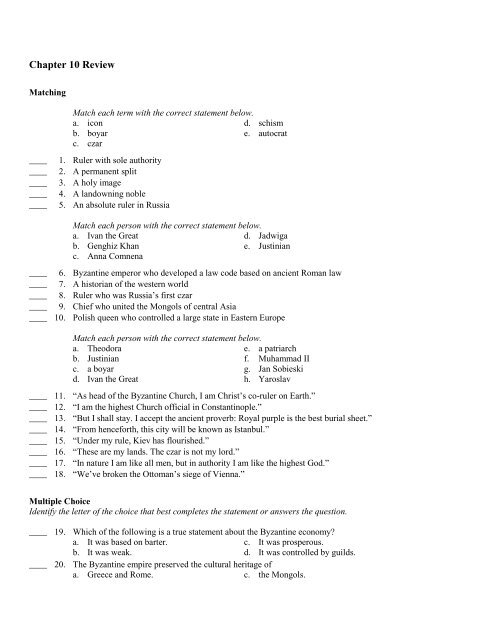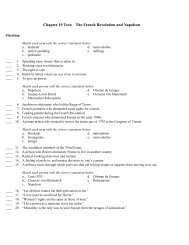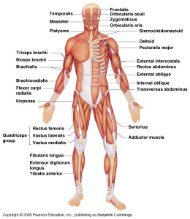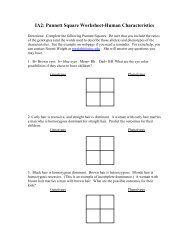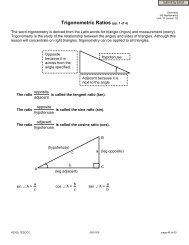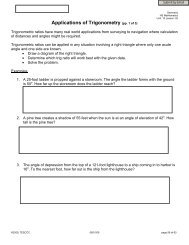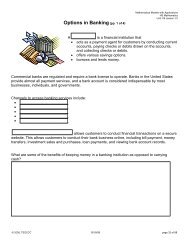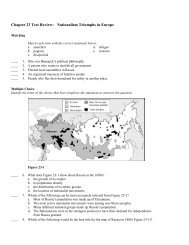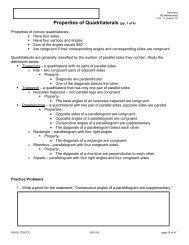Chapter 10 Review
Chapter 10 Review
Chapter 10 Review
You also want an ePaper? Increase the reach of your titles
YUMPU automatically turns print PDFs into web optimized ePapers that Google loves.
<strong>Chapter</strong> <strong>10</strong> <strong>Review</strong><br />
Matching<br />
Match each term with the correct statement below.<br />
a. icon d. schism<br />
b. boyar e. autocrat<br />
c. czar<br />
____ 1. Ruler with sole authority<br />
____ 2. A permanent split<br />
____ 3. A holy image<br />
____ 4. A landowning noble<br />
____ 5. An absolute ruler in Russia<br />
Match each person with the correct statement below.<br />
a. Ivan the Great d. Jadwiga<br />
b. Genghiz Khan e. Justinian<br />
c. Anna Comnena<br />
____ 6. Byzantine emperor who developed a law code based on ancient Roman law<br />
____ 7. A historian of the western world<br />
____ 8. Ruler who was Russia’s first czar<br />
____ 9. Chief who united the Mongols of central Asia<br />
____ <strong>10</strong>. Polish queen who controlled a large state in Eastern Europe<br />
Match each person with the correct statement below.<br />
a. Theodora e. a patriarch<br />
b. Justinian f. Muhammad II<br />
c. a boyar g. Jan Sobieski<br />
d. Ivan the Great h. Yaroslav<br />
____ 11. “As head of the Byzantine Church, I am Christ’s co-ruler on Earth.”<br />
____ 12. “I am the highest Church official in Constantinople.”<br />
____ 13. “But I shall stay. I accept the ancient proverb: Royal purple is the best burial sheet.”<br />
____ 14. “From henceforth, this city will be known as Istanbul.”<br />
____ 15. “Under my rule, Kiev has flourished.”<br />
____ 16. “These are my lands. The czar is not my lord.”<br />
____ 17. “In nature I am like all men, but in authority I am like the highest God.”<br />
____ 18. “We’ve broken the Ottoman’s siege of Vienna.”<br />
Multiple Choice<br />
Identify the letter of the choice that best completes the statement or answers the question.<br />
____ 19. Which of the following is a true statement about the Byzantine economy?<br />
a. It was based on barter. c. It was prosperous.<br />
b. It was weak. d. It was controlled by guilds.<br />
____ 20. The Byzantine empire preserved the cultural heritage of<br />
a. Greece and Rome. c. the Mongols.
. Russia. d. Western Europe.<br />
____ 21. Kiev was strongly influenced by the culture of<br />
a. Rome. c. the Ottoman Turks.<br />
b. the Byzantine empire. d. Persia.<br />
____ 22. What kind of government did Russian rulers develop?<br />
a. oligarchy c. democracy<br />
b. authoritarian or autocratic rule d. theocracy<br />
____ 23. Which of the following statements best describes the region of Eastern Europe?<br />
a. a culturally uniform region<br />
b. an isolated region<br />
c. a region of many peoples, languages, and cultural traditions<br />
d. a peaceful region<br />
____ 24. Which of the following religions had an impact on Poland and Hungary?<br />
a. Hinduism c. Orthodox Christianity<br />
b. Islam d. Roman Catholicism<br />
Figure <strong>10</strong>-1<br />
____ 25. According to Figure <strong>10</strong>-1, what body of water connects the Sea of Marmara to the Aegean Sea?<br />
a. Dardanelles c. Bosporus<br />
b. Black Sea d. Mediterranean Sea<br />
____ 26. According to Figure <strong>10</strong>-1, what is the main reason the Bosporus is an important waterway?<br />
a. It provides a passage from the Black Sea to the Mediterranean.<br />
b. It connects the Byzantine empire with the Ottoman empire.<br />
c. It connects the Black Sea to the Sea of Marmara.<br />
d. It provides Greece with access to the Black Sea.<br />
____ 27. According to Figure <strong>10</strong>-1, what is the narrow body of water connecting the Black Sea to the Sea of Marmara<br />
called?<br />
a. Aegean Sea c. Mediterranean Sea
. Bosporus d. Dardanelles<br />
____ 28. Looking at Figure <strong>10</strong>-1, which of the following statements best explains why Constantinople is<br />
advantageously located?<br />
a. It is situated on a crossroads between Europe and Asia.<br />
b. It is located in the Byzantine empire.<br />
c. It lies across from the Ottoman empire.<br />
d. It is near the Sea of Marmara.<br />
____ 29. The Byzantine empire reached its greatest size under<br />
a. Constantine. c. Muhammad II.<br />
b. Justinian. d. Vladimir.<br />
____ 30. Which of the following groups finally conquered the Byzantine empire?<br />
a. Ottoman Turks c. Latin Christians<br />
b. Seljuk Turks d. Arabs<br />
____ 31. Which of the following statements best describes the style of leadership that emerged in Russia?<br />
a. cooperative c. democratic<br />
b. compromising d. autocratic<br />
____ 32. Which of the following cities became the capital of Russia under the czars?<br />
a. Kiev c. Constantinople<br />
b. Kulikovo d. Moscow<br />
____ 33. Which of the following is associated with Ivan the Terrible?<br />
a. extreme absolute rule c. written law code<br />
b. victory over the Golden Horde d. cooperation with the Mongols<br />
____ 34. Which of the following statements is true?<br />
a. Most people in Eastern Europe are of French descent.<br />
b. Eastern Europe is home to many different cultural traditions.<br />
c. Byzantine culture greatly influenced Poland and Hungary.<br />
d. The Magyars are the dominant ethnic group in Eastern Europe.<br />
____ 35. Which of the following statements best explains why Eastern European kingdoms were so often invaded?<br />
a. The rulers were weak.<br />
b. There were few geographic barriers.<br />
c. They had no organized government.<br />
d. The rulers were preoccupied with matters outside of their borders.<br />
____ 36. Which of the following groups of people took refuge in Poland during the late Middle Ages?<br />
a. Slavs c. Serbs<br />
b. Jews d. Roman Catholics<br />
Short Answer<br />
37. List three ways Justinian tried to restore the glory of Rome to the Byzantine empire.<br />
38. List three ways the Byzantine empire influenced later civilizations, including Russia.<br />
39. Identify and explain the impact of each on early Russia: Slavs, Varangians, and Mongols.<br />
40. Describe how Ivan III became Russia’s first czar.<br />
41. List three methods the czars used to secure control of Russia.<br />
42. Explain how geography contributed to Eastern Europe’s ethnic diversity.<br />
43. List the four major religions in Eastern Europe and describe where they are located.
Essay<br />
Read the following excerpts from histories written by Procopius, a historian who lived during the time of<br />
Justinian. Then answer the questions that follow.<br />
From Buildings<br />
“Justinian created countless cities which did not exist before. And finding that the belief in God was,<br />
before his time, straying into errors and being forced to go in many directions, he completely destroyed<br />
all the paths leading to such errors, and brought it about that it stood on the firm foundation of a single<br />
faith. Moreover, finding the laws obscure because they had become far more numerous than they<br />
should be, and in obvious confusion because they disagreed with each other, he preserved them by<br />
cleansing them of the mass of their verbal trickery, and by controlling their discrepancies with the<br />
greatest firmness.”<br />
From the Secret History<br />
“Justinian was dissembling, crafty, hypocritical, secretive by temperament, two-faced; a clever fellow<br />
with marvelous ability to conceal his real opinion, and able to shed tears, not from any joy or sorrow,<br />
but employing them artfully when required in accordance with the immediate need, lying all the time;<br />
not carelessly, however, but confirming his undertakings both with his signature and with the most<br />
fearsome oaths, even when dealing with his own subjects.”<br />
44. Contrast the picture of Justinian found in each passage.<br />
45. Do you think it’s possible that both views of Justinian are truthful? Why or why not?<br />
46. Buildings was published while Procopius was alive, but the Secret History was published after the author’s<br />
death. Why do you think this was?<br />
47. Making Generalizations Make one generalization about Russian rulers. Support the generalization with<br />
two facts.<br />
48. Drawing Conclusions Explain how geography influenced Eastern European history.<br />
49. Predicting Consequences How do you think Russia might have developed differently if it had not been<br />
influenced by the Byzantine empire?<br />
50. Linking Past and Present How do long-standing ethnic differences still affect the Balkans today?<br />
51. Synthesizing Information Why do you think the Byzantine empire was so much more prosperous than the<br />
Holy Roman Empire during the Middle Ages?<br />
52. Drawing Conclusions Why do you think Eastern Europe has been the site of so much warfare?
<strong>Chapter</strong> <strong>10</strong> <strong>Review</strong><br />
Answer Section<br />
MATCHING<br />
1. ANS: E<br />
2. ANS: D<br />
3. ANS: A<br />
4. ANS: B<br />
5. ANS: C<br />
6. ANS: E<br />
7. ANS: C<br />
8. ANS: A<br />
9. ANS: B<br />
<strong>10</strong>. ANS: D<br />
11. ANS: B<br />
12. ANS: E<br />
13. ANS: A<br />
14. ANS: F<br />
15. ANS: H<br />
16. ANS: C<br />
17. ANS: D<br />
18. ANS: G<br />
MULTIPLE CHOICE<br />
19. ANS: C<br />
20. ANS: A<br />
21. ANS: B<br />
22. ANS: B<br />
23. ANS: C<br />
24. ANS: D<br />
25. ANS: A<br />
26. ANS: C<br />
27. ANS: B<br />
28. ANS: A<br />
29. ANS: B<br />
30. ANS: A<br />
31. ANS: D<br />
32. ANS: D<br />
33. ANS: A<br />
34. ANS: B<br />
35. ANS: B<br />
36. ANS: B
SHORT ANSWER<br />
ESSAY<br />
37. ANS:<br />
Justinian reconquered western provinces (North Africa, Italy, and Spain); beautified Constantinople<br />
(including constructing Hagia Sophia) to make it worthy of its title, the “New Rome”; and collected and<br />
revised ancient Roman laws.<br />
38. ANS:<br />
Answers should include three of the following: its scholars preserved and spread ancient Greek classics; its<br />
religion, Eastern Orthodox Christianity, spread to Eastern Europe and Russia; it provided Russia with a<br />
written script; its art, architecture, and music spread to Eastern Europe and Russia; Justinian’s law code<br />
influenced law in Eastern and Western Europe; and it established patterns in government, especially the close<br />
relationship between the church and state in Russia.<br />
39. ANS:<br />
Slavs—among the earliest people to settle Russia who set up farming villages and started trading;<br />
Varangians—Vikings from Scandinavia who established a thriving trade with Constantinople and brought<br />
Kiev into the Byzantine sphere of influence; and Mongols—nomadic people from central Asia who overran<br />
Russia and brought peace to the region but also cut it off from the rest of Europe and delayed its development<br />
in the arts and sciences.<br />
40. ANS:<br />
Ivan III brought a large area of Russia under his military control. Then he began building a framework for<br />
absolute political control, which included limiting the power of the land-owning nobles, adopting Byzantine<br />
court rituals to legitimize his authority, and giving himself the title of czar.<br />
41. ANS:<br />
Answers should include three of the following: exercised their military might, centralized political power,<br />
made an ally of the Eastern Orthodox church, took privileges away from the boyars, and used terror to<br />
frighten people.<br />
42. ANS:<br />
The lack of natural geographic barriers and the presence of rivers made migration into the region by many<br />
different groups easy.<br />
43. ANS:<br />
Roman Catholic Christianity—Poland, Hungary, Czech area, western Balkans; Islam—the Balkans; Eastern<br />
Orthodox Christianity—the Balkans; Judaism—Poland and Hungary.<br />
44. ANS:<br />
In the first passage, Procopius praises Justinian, and in the second he reviles him.<br />
45. ANS:<br />
Answers might include that it was possible for Justinian to make positive achievements while at the same<br />
time having a hypocritical nature.<br />
46. ANS:<br />
It would have been too dangerous for Procopius to publish the Secret History while Justinian was alive<br />
because the history was so unflattering.<br />
47. ANS:<br />
Possible answer: Generalization—Russian rulers were power hungry. Facts—they were absolute rulers; and<br />
they took away the rights of the boyars.<br />
48. ANS:
The lack of natural geographic boundaries encouraged many different groups to migrate to the region. It also<br />
made the region easy to invade.<br />
49. ANS:<br />
Possible answers: It would not have adopted Byzantine culture or religion; it might have come to be<br />
influenced by Western Europe and Roman Catholicism and developed a form of government that was less<br />
autocratic.<br />
50. ANS:<br />
Rival ethnic groups descended from Slavs who migrated to the region have fought in Bosnia and Kosovo. In<br />
part, the conflict can be traced to Ottoman rule and religious differences between the Bosnian Serbs, who are<br />
Christians, and the Croats, who are Muslims.<br />
51. ANS:<br />
Answers might include that its situation at the center of key trade routes between Europe and Asia played a<br />
large role. Also, its cosmopolitan character and open atmosphere invited opportunity.<br />
52. ANS:<br />
Answers might include that antagonisms among its many peoples made the area ripe for conflict; its physical<br />
geography made it especially vulnerable to invasion; its location put it at the crossroads of invading armies;<br />
its frequently changing political boundaries gave it a fluid quality that invited foreign powers to conquer it.


